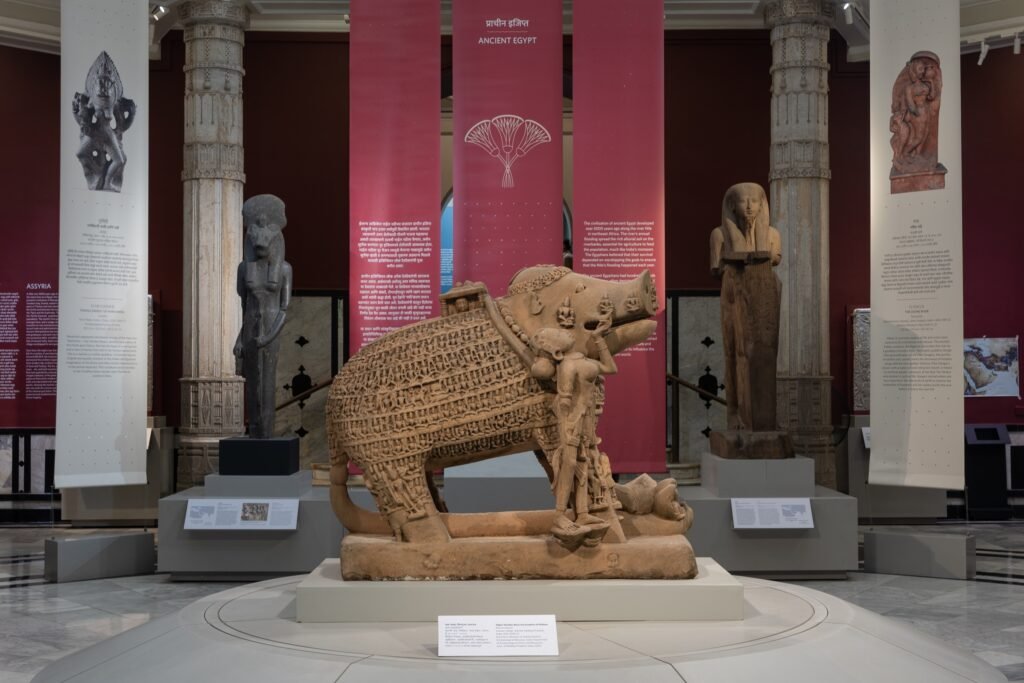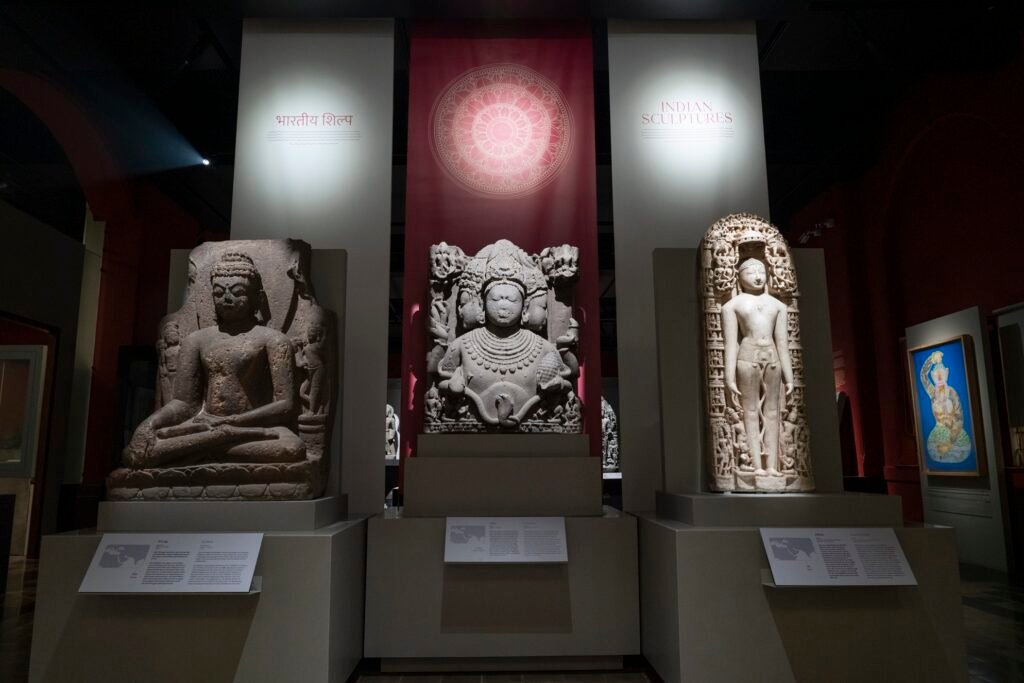4, Dec 2023
Chhatrapati Shivaji Maharaj Vastu Sangrahalaya And Partners Present A New Model Of International Co-Curation And Cooperation
Mumbai, 4th December 2023 – More than 65% of India’s vast population is under the age of 25. For most young Indians, the primary sources for understanding the world around them are schools, universities, books, and popular media. Indian museums can play a critical complementary role by providing direct experiences with original works of art, allowing people to reflect on, and draw their interpretations from, real evidence of history.
The Chhatrapati Shivaji Maharaj Vastu Sangrahalaya, CSMVS Museum, Mumbai attracts over a million visitors annually, most of whom are children and young adults. Working closely with universities, schools, and NGOs, CSMVS is a public-facing people-first museum, which, with its participatory approach, has been adaptive to the changing needs of the people. Today, it invests over 60% of its annual budget in education and outreach.
On the occasion of 75 years of Indian Independence and India’s Vasudeva Kutumbakam (‘the world is one family’) initiative, CSMVS Museum, Mumbai is honoured to present an exceptional tribute planned in association with its special international partners – the Getty, The British Museum, the Staatliche Museen Zu Berlin, as well as leading Indian museums.

With the opening of Ancient Sculptures: India Egypt Assyria Greece Rome, for the first time ever, the Indian public and the country’s young population will have the opportunity to view, and study the great artistic achievements of the ancient Mediterranean alongside India’s vast living heritage of sculptural traditions. In an act of extraordinary generosity, our international colleagues have allowed great works of art from their collections to remain at the CSMVS Museum, Mumbai for almost one year from December 2023 to October 2024. We are truly grateful for their trust and equally grateful to the Government of India and the Government of Maharashtra for their support.
In early 2025, this ambitious collaboration will culminate in the opening of an Ancient World Gallery at the CSMVS, where the partners once again will share their collections, lending well over 100 objects.
In a pioneering exercise of global co-curation, unprecedented both in India and abroad, objects for the present exhibition were chosen by Indian curators to take their place in Indian narratives of antiquity, joining and complementing cultural histories from ancient Greece and Rome. Curators from CSMVS Museum Mumbai, with their colleagues from the participating museums have chosen sculptures to be exhibited alongside objects from their collection.
This long-term project of sharing collections is made possible through the generous support of the Getty.
The themes will explore traditions that shaped ancient cultures, many of which continue to dominate aspects of society today such as the role of nature in human lives, the divine form, and concepts of beauty. Displayed beside the Museum’s Indian collections, the visiting sculptures will demonstrate the interconnectedness of the ancient world — and the extraordinary longevity of India’s cultural traditions.
The experience will be further enriched through immersive gallery walks, a multilingual audio guide, and short films featuring experts from different parts of the world talking about the exhibits.

India And Its Role In The Ancient World
As India continues to commemorate 75 years of independence across the nation and the globe, this project highlights the rich history of the ancient world and India’s position in it. Young Indian visitors will explore India’s centuries-old capacity to cradle and sustain a diversity of ideas and cultures, both from within and outside the subcontinent, underscoring thousands of years of cultural exchange.
“More than 65% of India’s vast population is under the age of 25. For decades, school children and university students in India have learned about ancient Egypt and Mesopotamia, Greece and Rome, but until now they have not been able to study at first-hand any of the great works of art that these civilisations produced. We see the exhibition as a unique and important educational endeavour that provides our Indian audiences and children with new ways of viewing their own culture as a result of seeing it in relation to other societies and geographies” said Sabyasachi Mukherjee, director general of the Chhatrapati Shivaji Maharaj Vastu Sangrahalaya, Mumbai.
A New Model For Museum-University Partnership
The impact of the project will be increased and strengthened through school and university programmes across the country that will enable teachers and professors to introduce teaching with original art objects. The initiative will also enable micro-exhibitions onboard CSMVS’s mobile travelling buses, the Citi-CSMVS Museum on Wheels, that will ensure the project’s learning seeps deep into the cultural fabric of rural India.
This Pilot Project is a prelude to the larger initiative of the Ancient World Gallery which is planned to open in early 2025 — a new gallery on the ancient civilisations at CSMVS, which is planned to open in 2025. Both projects together hope to reach out to 5 million people physically, nearly 60 percent of whom will be school and university students; and 1 million digitally, to redefine the role of museums in formal learning, thereby widening their educational and social contribution.
Discussions with a group of universities from across the sub-continent has led to an ambitious undertaking, which will be developed in association with Cambridge University’s Global Humanities Programme. Because of the exceptional length of loan for both phases, it will be possible for universities to devise a bespoke curriculum, specifically designed to take advantage of the presence of the visiting objects. For more distant universities, preliminary teaching may be done on campus remotely, to be followed by visits to Mumbai and the Museum. Lectures and seminars will be given by both Indian and international scholars: among these, there will be, crucially, specialists from the source countries — thus offering a range of perspectives which should lead to many new insights.
CSMVS has also planned a series of lectures, films, and other activities, many of which will take place in Maharashtra and several cities outside of Mumbai.
“CSMVS has organized a fantastic exhibition that infuses art from European collections and Getty with fresh ways of looking and understanding – and brings CSMVS’ own objects into a larger global narrative,” said Katherine Fleming, President, and CEO of Getty. “This is our objective in supporting cross-continent collection sharing.”
Sabyasachi Mukherjee, Director General, Chhatrapati Shivaji Maharaj Vastu Sangrahalaya, Mumbai, said that “We see ‘Ancient Sculptures: India Egypt Assyria Greece Rome’ as a unique and important educational endeavour providing our Indian audiences and children (in particular the high percentage of India’s young people who might never have the opportunity to travel and experience the art and culture of other parts of the world), with new ways of viewing their own culture as a result of seeing it in relation to other societies and geographies. It is intended that this project have not just local but national and international outreach and that it might introduce new ways of approaching information and learning that have the potential of being introduced into our own school and university curricula. The Public programming, Metro City outreach initiative, the University programme, and the Museum’s extended education services are designed to encourage large numbers of young adults to visit the exhibition and to leave it with a new understanding not only of Indian history in the ancient world but also of their own proud place within it as citizens of the world.
Neil MacGregor, Advisor to the Getty’s sharing collections programme said, “This small exhibition is a huge experiment. Here for the first time is the ancient world seen and interrogated not from a European point of view but from the standpoint of India”.
Prof. Dr. Hermann Parzinger, President, of Stiftung Preußischer Kulturbesitz said that ”For the Berlin museums, this major long-term partnership with CSMVS is a welcome step towards deepening our ties with India, and we look forward to working together on the next stage of this enlightened project of sharing our collections in the years to come’.
The Next Stage: The Ancient World Gallery At CSMVS 2025
Having the Museum’s collection of ancient Indian material as its core, and drawing on the collections of our partners, the new gallery will focus on the four river cultures of Harappa (Indus civilisation), Mesopotamia, Egypt, and China. Expanding into the Persian, Greek and Roman worlds, it will stress the legacies and oftentimes interconnectedness of these civilisations and how they continue to impact the world today. The Ancient World Gallery will once again be a collaboration of the four partner museums, supported by Getty.
- 0
- By Rabindra







